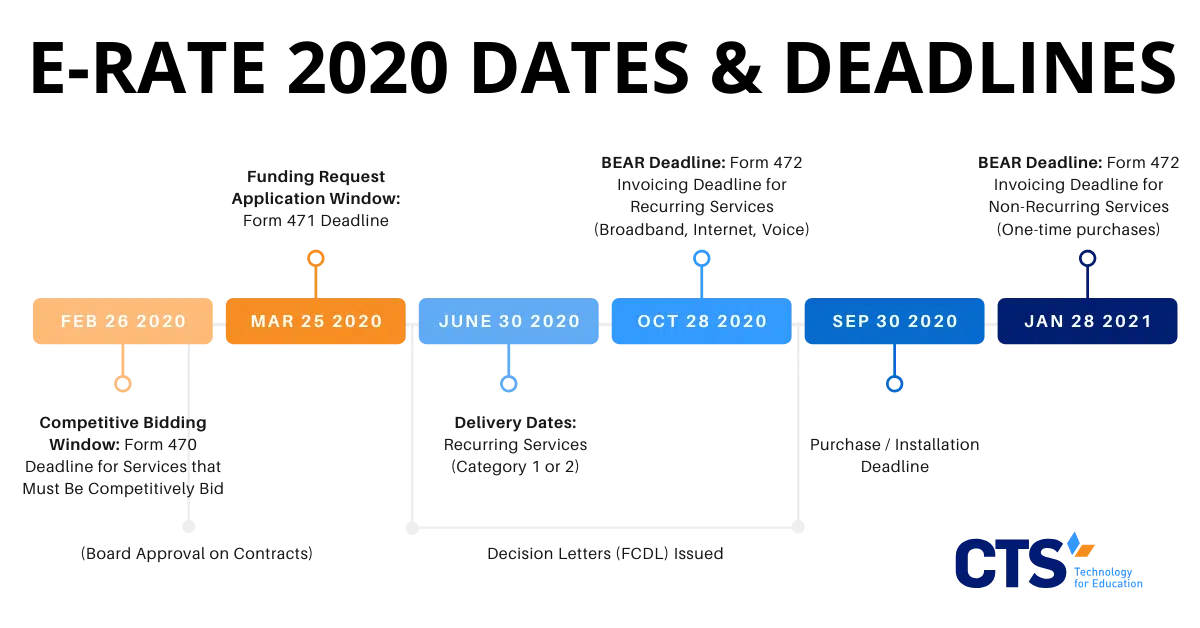Decide how to spend your 2020-21 E-rate funds by February 26th, at the latest.
This year’s E-rate filing window opened January 15th and will close on March 25th, meaning your Form 470 must be certified in EPC by February 26th, at the latest. As any school administrator knows, spring is a particularly busy time: parent-teacher conferences, State Test preparation, local and state compliance requirements abound, making it difficult to prioritize the demands of the federal E-rate program.

At CTS, we pride ourselves on deeply understanding the needs of our clients and, in particular, on understanding the unique challenges facing school administrators. Rather than merely a technology provider, we view ourselves as deeply ingrained in the work of supporting schools in leveraging educational technology. Put simply, we’re here to help you navigate the E-rate bidding process to make the most of your 2020-21 E-rate funds.
All schools will receive additional Category 2 funding in 2020. It’s here to stay!
This funding year is particularly special. In December, the FCC announced that all schools would receive an additional 20% of Category 2 E-rate funding for the 2020-21 fiscal year, despite persistent rumors that such funding would be eliminated altogether.
What does this mean for schools? Well, now is the time to invest in your internal connections, such as WiFi access points, switches, routers, firewalls, and any associated licenses. If you’re adding a new site, these additional funds could be especially useful for offsetting the costs associated with school start-up. Of course, even if you’re not expanding your district’s footprint, these funds could be used to augment your existing technology infrastructure, improving internet speed, access, and overall functionality for the next school year.
Use all of your E-rate funds for the 2020-21 school year. They won’t roll over to 2021-22.
In fact, if you don’t use these funds now, you’ll lose them forever. In addition to announcing an increase in Category 2 funding, the FCC has implemented new rules governing E-rate budgeting cycles.
Beginning in 2021, funding will follow a five-year cycle (2021-2026, 2026-2031, and so on). At the end of each cycle, schools’ budgets will be reset, eliminating any unspent funds. Within each cycle, unused funds will continue to roll over to the following year.
Importantly, the per-student funding amount will no longer increase with inflation each year, but will instead remain constant for the duration of each five-year cycle. For the 2020-21 funding year, the per-student amount is $167, with schools’ budgets dictated by their total student counts at the beginning of each cycle. Should a school’s enrollment increase within a funding cycle, the student count can be updated to reflect this change.
Partnering with a strong E-rate consultant can increase the effectiveness of your funds.
CTS is well aware of the challenges facing schools, both in terms of time and personnel. Our partners often wear many hats, ranging from testing coordinator, business manager, enrollment associate, and even food service director. Needless to say, a full-time staff member devoted solely to IT, let alone navigating the E-rate funding process, is exceedingly rare.
And that’s where we come in, leveraging your school’s E-rate funds to bridge the gap between technology, finance, and instructional goals to make the most of every dollar. To date, our partner schools have been awarded $10 million, with each year’s allocation individually tailored to meet the short- and long-term needs of each school.
As a full-scale IT provider serving more than 20,000 students, we have unique insight into how funding choices within each E-rate category form a cohesive technology landscape, with the recognition that each partner has a unique mission and school design that often depends on reliable instructional technology.
We use our expertise to deliver a compliant, personalized infrastructure at an optimal cost.
Schools without the resources to thoughtfully parse the E-rate process can end up accepting a vendor proposal that contains ineligible items. Did you get your teachers excited about a new student information system you were planning to launch next school year? Have you planned to enhance your internal connectivity with supposedly state-of-the-art wireless infrastructure? Too bad. It turns out those items aren’t covered by your E-rate funds.
We make sure this scenario isn’t a reality for our partners, thoughtfully evaluating your school’s existing technology infrastructure to solicit bids to fit your needs. For example, we launch each partnership with a predictive WiFi survey of your facility. Do you know that particular corner of your building or closet-office space where the internet connection is especially poor? We’ll be sure to find it and make sure it’s considered as part of your E-rate bid.
We’ll tell you about shiny new toys, while also remaining fiscally responsible.
We’ll also make sure you stay current. Educational technology, much like the E-rate process, is a dynamic, ever-changing space. We recognize that the educational software or hardware you’ve been using for the past three school years may not cut it the next time around. It’s our job to make sure you’re fully aware of your funding choices and to alert you when we see an area where a newer technology makes sense at your site.
With that said, experience tells us that cost is often the most significant factor in making E-rate funding decisions. Our technical expertise allows us to triangulate your budgetary, human capital, and facility constraints to deliver a cost-conscious bid for potential vendors. Simply put, we won’t force you to choose between achieving your school’s mission and going into the red.
E-rate doesn’t have to be that hard. No, really.
If there’s one thing we hope you know, it’s that successfully navigating the E-rate process doesn’t have to be that hard. In fact, it can add significant value to your instructional program while also maintaining fiscal integrity.
It’s not enough to throw an E-Rate bid against the wall and see what sticks: it’s imperative that your school thoughtfully determine its technological capacity and instructional needs to design a proposal that supports student learning. Doing so can make the difference between an instructional technology program that simply “replaces” more traditional teaching methods and another that transforms your school into something truly exceptional.
You’re managing arrival, dismissal, lunch, recess, and so much more that’s invisible to students and families. The last thing you want is another task that risks taking your time away from the day-to-day needs of teachers and the kids in their charge. CTS can help you deliver an E-rate solution that saves you time, money, and, most importantly, uses your 2020-21 E-rate funds to further the unique mission of your school. Accelerate your E-rate process as the dates get nearer: let’s talk about your E-rate opportunities, or click here for more on E-rate.




